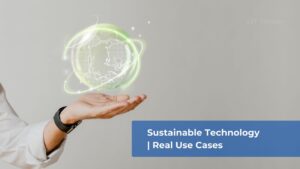








ITC Group - Listen to the article:
Sustainable Technology’s application in real life
/
00:00
Sustainable technologies are now more than ever woven into the very fabric of our daily lives, with a particular emphasis on their integration into the operations of businesses. It’s not just a trend; many experts and corporate leaders now view sustainability as a non-negotiable element that must be ingrained in the core values and practices of companies. Given that technology is the driving force behind corporate evolution, this blog post aims to delve deep into specific examples of sustainable technologies and provide a comprehensive overview of the current landscape of solutions.
To gain a more profound understanding of sustainable technology, delve into the details here!
The transition to cloud services, exemplified by platforms like Azure, holds remarkable potential for enhancing energy efficiency—up to 93%. Furthermore, it can be up to 98% more carbon-efficient than local servers.
As a noteworthy success story, Asisa Group’s migration of 3 Terabytes of databases to Azure resulted in over 50% resource savings and SQL Server optimization. [Read the detailed success story]
The staggering production of 800 tons of paper per minute poses significant environmental challenges, with up to 50% of waste in many businesses comprising documents and printed matter.
Technological solutions, such as eco-friendly digital boarding systems implemented by companies like Trasmediterránea and plain concepts, eliminate the need for physical forms, preventing the generation of millions of boarding passes annually.
Climate change-induced water challenges, including droughts and floods, transform landscapes and necessitate human migration.
Smart technologies, ranging from flood risk warnings utilizing satellite data to smart metering preventing leaks in buildings, play a vital role in water conservation and sustainability.
Companies are increasingly setting ambitious carbon neutrality targets, with technology playing a pivotal role in achieving these goals.
Innovations like factories removing carbon dioxide from the air, exemplified by the facility in Iceland transforming it into rock, present groundbreaking solutions to carbon emissions.
The expansion of 5G networks extends beyond improved speed and reduced latency, impacting sectors like smart agriculture by enhancing real-time information about crops.
This heightened connectivity reduces reliance on excessive fertilizer, pesticides, and water, significantly mitigating climate change.
Technology stands at the forefront of sustainability efforts, providing nuanced solutions to complex environmental challenges and shaping a more sustainable future. By championing renewable energy, transforming agricultural practices, and advancing transportation technologies, we collectively contribute to creating a healthier planet for present and future generations. For those eager for additional in-depth articles on green energy sources, a wealth of information awaits here.
Stay ahead in a rapidly changing world with our monthly look at the critical challenges confronting businesses on a global scale, sent straight to your inbox.